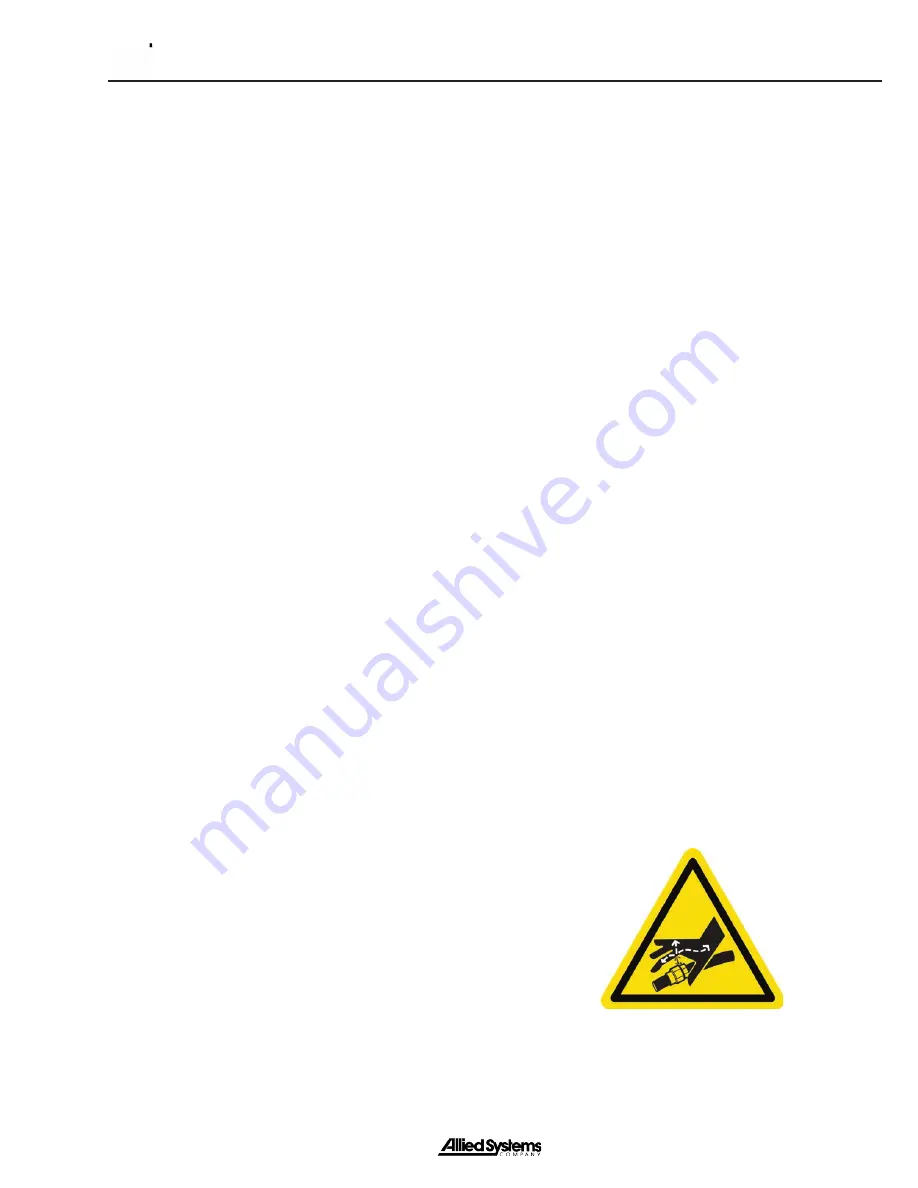
iii
Safety Summary
•
Make sure ground personnel are in plain view of the
operator, and at a distance of at least 1½ times the
working length of the wire rope.
•
Make sure that any hand signals used by ground
personnel are clearly defined and understood by
everyone involved.
•
Do not attempt to “jerk” or “shock” a load free. Doing
so can cause loads in excess of the rated capacity
of the wire rope, winch, or mounting hardware.
•
Replace any parts only with genuine Allied Winch
parts. Refer to Parts Manual 599039W.
•
Maintain
a minimum of three (3) complete wraps
of wire rope
on the drum for normal operation. It
may help to paint the last five wraps of wire rope
a contrasting color, to serve as a visual indicator.
•
Do not handle wire rope with bare hands. Wear
leather gloves at all times.
•
Align the tractor with the load to prevent side loading
the winch, and to maintain even spooling of the
wire rope.
•
If applying tension to the wire rope manually during
spooling:
x
ensure that the operator is winching in slowly,
x
keep your hands and clothing well clear of any
rollers or the winch drum,
x
do not maintain tension by letting the wire rope
to slip through your hands,
x
use a hand-over-hand technique to maintain
tension.
•
Be aware of the ground conditions, and make sure
the ground and tractor are stable enough to pull
the intended load.
•
Do not attempt to pull loads in excess of the rated
capacity of the winch.
•
Keep yourself informed of any applicable codes,
regulations and standards for the job.
•
Your winch may have temperature shut-off system
for protection of tractor and winch. Manual override
of high temperature shut-off will cause damage to
tractor and winch.
•
This winch is neither intended, designed, nor rated
for any application involved in the lifting or moving
of personnel.
•
Use only the lubricants listed in the Recommended
Oil List. See page 1-4.
•
Do not weld on any part of the winch. Contact Allied
Systems if weld repairs are needed.
•
The hydraulic system must be kept clean and free
of contamination at all times.
•
Be aware of the hazards of pressurized hydraulics:
x
Wear personal protective equipment, such as
gloves and safety glasses, whenever servicing
or checking a hydraulic system.
x
Assume that all hydraulic hoses and components
are pressurized. Relieve all hydraulic pressure
before disconnecting any hydraulic line.
x
Never try to stop or check for a hydraulic leak
with any part of your body; use a piece of
cardboard to check for hydraulic leaks.
x
Small hydraulic hose leaks are extremely
dangerous, and can inject hydraulic oil under
the skin, even through gloves.
x
Infection and gangrene are possible when
hydraulic oil penetrates the skin. See a doctor
immediately to prevent loss of limb or death.
Summary of Contents for H6H
Page 3: ......
Page 9: ...vi Notes...
Page 49: ...General 1 40 Notes...
Page 65: ...General 1 56 Notes Notes...
Page 71: ...Troubleshooting 2 6 Notes...
Page 78: ...Section 3 3 7 Notes...
Page 79: ...Service 3 8 Notes...
Page 84: ...Section 4 4 5 Intentionally Blank...
Page 92: ...Section 4 4 13 7 Remove the counterbalance relief manifold...
Page 96: ...Section 4 4 17 Intentionally Blank...
Page 98: ...Section 4 4 19 7 Separate the clutch hub and the pressure plate CLUTCH HUB PRESSURE PLATE...
Page 102: ...Section 4 4 23 Intentionally Blank...
Page 112: ...Section 4 4 33 Intentionally Blank...
Page 126: ...Section 4 4 47 Intentionally Blank...
Page 132: ...Section 4 4 53 Notes...

































